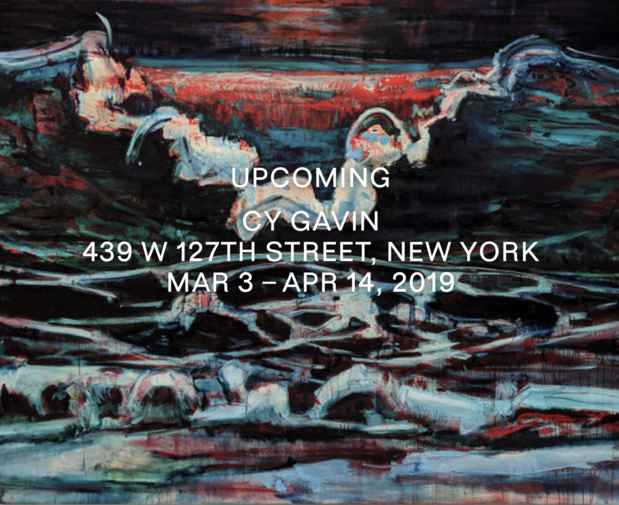Cy Gavin Exhibition
Gavin Brown's Enterprise

This event has ended.
Gavin Brown’s enterprise presents an exhibition of paintings by Cy Gavin. It is the artist’s first show with the gallery.
Comprised of new paintings, the exhibition features a series of nocturnal landscapes exploring ancestry and colonial histories in Bermuda, the homeland of the artist’s father, and the Hudson Valley, where the artist’s studio is based. A departure from figuration, the works are portraits of places – the landscapes serve as proxies for the body.
The centerpiece of the exhibition, Bash Bish Falls, is a 12-by-28 foot painting of the well-known waterfall, which is located on the border of New York and Massachusetts in a gorge formed in the last ice age. According to lore, the site is named after a Mohican woman who met her death after being pushed over the waterfall. Though there were witnesses to her murder, her body was never recovered. The site is one of many in Hudson Valley with a native name and a forgotten or obfuscated narrative. Gavin visited the site during the full lunar eclipse in February of this year, painting the work alone in the desolation of a freezing winter night with a consciousness of a changing global climate.
Isolation, furthermore abandonment, is a theme Gavin explores in the landscapes of Bermuda. Untitled (Gibbet Island) depicts the Bermudian island on which runaway slaves were hanged by gibbet as a warning to other possible insurgents. Purposely removed from Bermuda’s main island, Gibbet Island appeased a contemporaneous mythology that put forth that the souls of the condemned could only haunt their assailants if they were killed on the same land: disturbing but tacit proof of personhood. Gavin painted the work to refer to the body – the cave can be seen as layers of skin, hair or even marks on the body like wounds or bruises.
The dark Bermudian cedar and palmetto woods of the island, as seen in the painting, are eerie and disorienting at first glance – we sense that something troubling has happened even if it cannot be seen.
The methods for creating these paintings are influenced heavily by Gavin’s interest in evolution, particularly the Purkinje Shift, a biological phenomenon in which the human eye evolved over millennia to favor the blue end of the visible light spectrum in situations of low illumination. To depict
luminous, dark passages Gavin layers his paintings in translucent blues, reds, greens and yellows. One color on top of the next, largely eschewing the use of carbon-based black paint. The super- spectral orange used in many of the works on view serves another illusory function: to offset and enhance the perception of the highly saturated blues that the human eye is apt to see at medium-to- low levels of light.
Gavin studied Maroon communities, fugitive slaves who established their own societies in remote areas throughout the Caribbean. For Maroons, there was security in being unseen. Freedom was achieved in the darkness, thus many communities were nocturnal. In Untitled (Glade), we see a tropical forest that is indecipherable, until the eye adjusts to reveal dark, unknown passages and a body of water. As the viewer begins to register the scene, questions arise. Where do the paths lead and who occupies this space?
All of the works on view depict liminal spaces where land meets water. Gavin attempts to reconcile the complexities of these sites that represent confrontation, communion, luxury, despair and hope all at once. We see where land ends and the water begins. We understand water and stone as a
rejuvenative and destructive force that can bury or preserve history and we reckon with the transmutative nature of matter itself. Gavin’s paintings depict restorative and restrictive sites – boundaries and thresholds.
Media
Schedule
from March 03, 2019 to April 14, 2019
Opening Reception on 2019-03-03 from 15:00 to 18:00